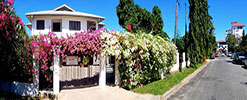Planning your Scuba Diving Holiday in Fiji

Overview
Fiji scuba diving holidays are amongst the best in the world with thousands of dive sites, dive operators at most resorts, dedicated dive resorts with all the latest equipment and instruction, and several excellent live aboard dive charters to explore the unexplored reefs of the outer islands. Highlights include a fantastic variety of colourful soft corals, over 1200 species of fish, 12 species of whales and dolphins, lots of specialist scuba diving resorts and live aboard dive charters as well as excellent snorkelling off the beach. Fiji dive sites offer good variety and easy access.
Over 400 species of corals, sea walls and drops
Fantastic marine life including bull sharks, turtles and manta rays
Advanced drift dives and some wreck dives
The Astrolabe Reef - Kadavu, Southern Islands
Rainbow Reef between Taveuni and Vanua Levu, Northern Islands
Beautifully warm seas all year round (26c - 31c)
Scuba Diving Practicalities
Throughout the islands, coral reefs are accessible either directly from the beach (ideal for beginners and non-dive partners to enjoy snorkelling) or for the more specific sights, just a short boat ride away. Most resorts in Fiji offer PADI dive courses, starting from the comfort of the resort swimming pool but quickly moving into the wonders of shallow coral seas.
Many of the dive operations will be independent companies operating from the premises of the resort. The majority are active members of the Fiji Dive Operators Association and agree to be bound by the Association's code of practice and thereby support the Fiji Recompression Chamber Facility. In cases of diving emergencies, divers will be taken by sea, road or air for re-compression treatment. Charges vary according to circumstances so it is best to have adequate insurance cover. At some of the smaller budget resorts cowboys do exist, so choose carefully and if you're a beginner, don't jump to the chance of diving without proper PADI certified instruction.
Certified PADI dive prices for a two-tank dive start from around the F$150 mark and an open-water course with 4 dives start from F$700.

PLEASE NOTE - No dive can be undertaken 24 hours prior to flying (local or international flights).
Top Rated Fiji Dive Sites
There are so many wonderful dive sites in Fiji that it's difficult to know where to begin.The best known coral reefs in Fiji are the Rainbow Reef between Vanua Levu and Taveuni (best access from Taveuni resorts); and the Astrolabe Reef which wraps itself around the east side of Kadavu. These are both big reefs with numerous dive sites and are have excellent drop-offs and drift dives for advanced divers, as well as stunning soft corals for the which can be enjoyed by all, even beginners.
The only problem faced by dive novices or casual holiday-divers in these specific dive-orientated resorts is that you may feel over-powered being surrounded by dive fanatics; and if there are only one or two novices, you may have to accompany these advanced divers on dive excursions and miss out on sites more geared to your level. For this reason, holiday-divers are often better catered for in the Mamanuca Islands and Yasawa Islands. That's not to say the dive sites here are inferior. There are in fact some very good coral reefs, drop-off's, drift dives, wrecks and shark encounters to enjoy in these waters too and it is probably as good a place as anywhere in Fiji to see dolphins and turtle.
If you're wanting to dive nutrient rich passages which attract the big pelagics: bull sharks, tiger sharks, tuna, barracuda and Trevally often in great numbers, then the passages north and south of Viti Levu are the places to head: namely offshore fromNananu-i-Ra island / Savusavu in the north; and around Beqa Lagoon in the south.
Viti Levu & Beqa Lagoon
The majority of Viti Levu is not great for scuba diving although there are two spots with some of the most sought after dive sites in Fiji.
Off the north coast of Viti Levu, is the Vatu-i-Ra passage with some of the most extensive dive sites in the islands - many reefs here are still undiscovered. There is limited accomodation in this region with only a small cluster of hotels around Rakiraki & on Nananu-i-Ra Island, mostly for budget travellers.
The famous shark feed at Beqa Lagoon offers close encounters with many species of sharks including bull sharks and tigers - it's located an hour boat ride from Pacific Harbour on the southern tip of Viti Levu with daily departures. Beqa Lagoon not only has sharks but is also renowned for its soft corals and pelagics.
Kadavu Island
World famous Astrolabe Reef on Kadavu in the Southern Islands (45 minutes flight from Nadi) has excellent hard and soft corals and excellent marine life. More soft corals along the north and south coast with some excellent caves and deep drop-off's on the western tip of Kadavu. Good all-round diving centre but south-easterly tradewinds can make diving difficult at times. On calm days, visibility up to 150 metres. Beqa Lagoon to the north of Kadavu includes numerous soft corals, reef bommies and passages. Small secluded dive resorts accessible only by boat. Lush rainforest and tropical beaches. Humid and wet at times. Very traditional Fijian lifestyle and culture.
Vanua Levu & Taveuni
World famous Rainbow Reef in Northern Islands (1 hour 20 minutes flight to Taveuni lies between Taveuni and Vanua Levu and has lots of scuba diving experiences including the Great White Wall (all white soft corals) and advanced drift diving through channels. Numerous smaller reefs around Vanua Levu, Taveuni, Qamea, Laucala and Matangi Islands with abundance of soft and hard corals and excellent marine life. There are excellent drift dives and corals around Namena Island off Savusavu Town where several dive operators are based. The Northern Islands have been developed for Eco-tourism as well as diving and the regions outstanding mountains, rainforests and waterfalls are all relatively accessible with tours and trails to the major attractions. These islands can be humid and wet at times.
Mamanuca Islands
Rich nutrients carried by strong south-easterly currents feed the Malolo Barrier Reef, a ten mile long system along the south-eastern side of the group which extends to Castaway Passage. This nutrient flows create the best setting for marine life in the western side of Fiji with over 400 species of colourful reef fish as well as dolphins, sharks and turtles. Hard and soft corals, fans, caves and pinnacles set as the backdrop.
Unfortunately, such is the popularity of the Mamanucas and resort-diving that many divers are either novices or recreation divers and some have little consideration for the protection of the reef or the marine environment. Shark and fish feeding is common to make the dives more appealing, look but don’t touch practice is often overlooked and the popular dive sites can be overcrowded. For a more peaceful environment, dive the Outer Reef around the islands of Tokoriki, Monuriki and Vomo where large pelagics are common and some unusual sites make diving for beginners and experienced divers a more fulfilling experience.
The compact nature of the group means that all dive sites are accessible from all resorts but even so, the further out you are, the better the dive quality and expereince.
Yasawa Islands
Although the Yasawas have fantastic snorkelling lagoons, scuba diving is rather more limited. more so because there are fewer dive operators in this region. There are good diving reefs and great caves to explore off Kuata Island in the Southern Yasawas and a number of coral reefs around Nanuya Island in the Northern Yasawas.
Ovalau Region
Two separate barrier reefs between Viti Levu and Vanua Levu in the north east of Fiji are assessable from Nananu-i-Ra and the Lomaiviti Group. Rich area fed by tradewind currents with excellent marine life including Manta Rays and hammerheads as well as bommies and pinnacles in the lagoons. A handful of small island resorts, some luxurious. Also accessible by charter dive boats that explore some of the unexplored areas of these huge reefs including the up-and-coming E6 reef. Shipwrecks can be explored around the old Colonial capital of Levuka on Ovalau.
Scuba diving holidays in other South Pacific Islands



